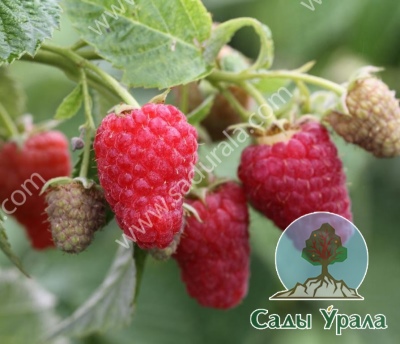
- Authors: Scotland, Scottish Crop Research Institute
- Berry color: crimson red
- Taste: bright, sweet with a slight sourness
- Ripening period: early
- Berry weight, g: 5-6
- Frost resistance: winter hardy
- Appointment: for the fresh market and processing
- Drop off location: in open and protected ground (film tunnels, greenhouses)
- Fruiting period: second half of June
- Yield rate: high
Gardeners always want to try to plant new varieties on their site. Among the new types of raspberries, the Glen Fine raspberry is especially popular. In this article, we will consider the features of the variety, yield, planting rules, as well as breeding methods.
Breeding history of the variety
Breeder Nikki Jennings is from Scotland. He breeds quite a lot of raspberries. And at the Scottish Institute he created several species, calling them by the common name Glen. And the middle name is considered a variety of the variety. This culture entered the market in 2009.
Description of the variety
Raspberry Glen Fine has strong and powerful roots. The adventitious roots are located shallow in the ground, only at a distance of 50 cm, and in denser, clayey areas, the roots germinate only 15 cm. The adventitious roots are responsible for the formation of new young shoots. Therefore, when the earth is loosened around the raspberries, it is worth doing it very carefully.
The vine is tall, reaches 2.5-3 m in length, without thorns. Replacement shoots live on average only 2 seasons. The branches are not spreading, but since they are very high, it is necessary to think over a support system or trellis.
Ripening terms
The variety belongs to the early ripening period. Ripening dates for raspberries depend on the region. The warmer the region, the earlier maturation begins. On average, this is mid-June, and ripening continues for 45-50 days.
Yield
Raspberry Glen Fine has a high yield. Berries during the vegetative period do not crumble, they firmly hold on to the stalk. The yield indicators are as follows: up to 4.5 kg of berries are removed from one bush, from one m2 to 30 kg, but from one hectare to 30-35 tons.
Berries and their taste
The berries are deep red, round and elongated. The weight of one berry is 6 g, the larger ones reach 10 g. The pulp is juicy and dense, the taste is sweet, not cloying, there is a slight sourness. The aroma is pronounced.

Growing features
Raspberry Glen Fine is unpretentious in care, you just need to follow the rules of agricultural technology in order to harvest a good harvest. It is important to adhere to a watering and feeding schedule. And also periodically loosen the ground and remove weeds. Tie up vines, while removing excess shoots.
Site selection and soil preparation
Before landing, the land is pre-processed and dug up. Humus and minerals containing nitrogen are added. The soil is given time to rest, and only then the seedlings are planted.
Since the root system of the Glen Fine raspberry is small, the pits are dug no more than 0.4 m deep or slightly less so that the root collar is above the ground. The shoots are lowered into the hole and covered with fertilized fresh soil.Around the branch, the earth is compacted and, if desired, covered with mulch.
Seedlings are planted at a distance of 0.5 m from each other, and between rows 2 m.If raspberry is grown on plantations where industrial equipment is used, then the distance between seedlings is 1 m, but between rows is 3-4.5 m.


Pruning
Pruning of this raspberry is advised to be carried out in 3 stages.
After the harvest is harvested, in the fall, all vines that have borne fruit in this season are removed.
Before the first snow, all weak branches and those that were affected by the disease are removed.
In the spring, branches are removed that are frozen or broken from snow.
All manipulations with cutting are carried out with a sharp secateurs, after each cut, the tool is processed. And the place of the cut is covered with garden pitch.

Watering and feeding
After planting the seedlings, they are watered on the fifth day. Glen Fine tolerates drought well, so you shouldn't worry about constant watering. You need to water the bushes as the soil dries out. To retain moisture around the bushes, the ground can be laid with mulch.
It is necessary to feed raspberries annually, since due to the abundant fruiting of minerals, little remains in the root system, and this can have a bad effect on wintering. Therefore, it is worth feeding from the beginning of spring, throughout the summer and for the last time after harvesting. Potassium or superphosphate is most often chosen for feeding, as well as organic fertilizers.


Frost resistance and preparation for winter
Although the producers indicate that this raspberry is very frost-hardy, many gardeners note that the culture loves heat more and does not tolerate severe frosts well. Therefore, it is necessary to remove it for the winter. To do this, you need to remove all the branches from the trellises, carefully roll up the vines and, having tied them, lay them on the boards. This is done so that there is no direct contact with the ground. Insulate with a covering or agrofiber.


Unfortunately, raspberries, like other plants, do not bypass various diseases and pests. Only armed with the knowledge and the necessary means for this, you can cope with such troubles.To help the plant, it is very important to be able to recognize the disease in time and begin timely treatment.
Reproduction
Raspberry Glen Fine reproduces by side shoots. This greatly facilitates the task, since there is no need to divide the bush by the root method, and also to make cuttings. But many gardeners choose these methods as well.








































































